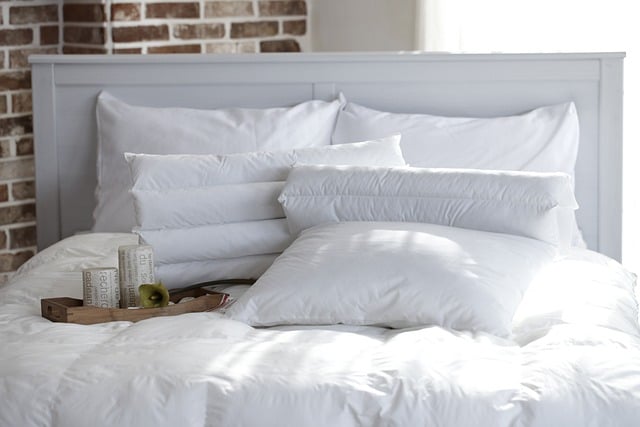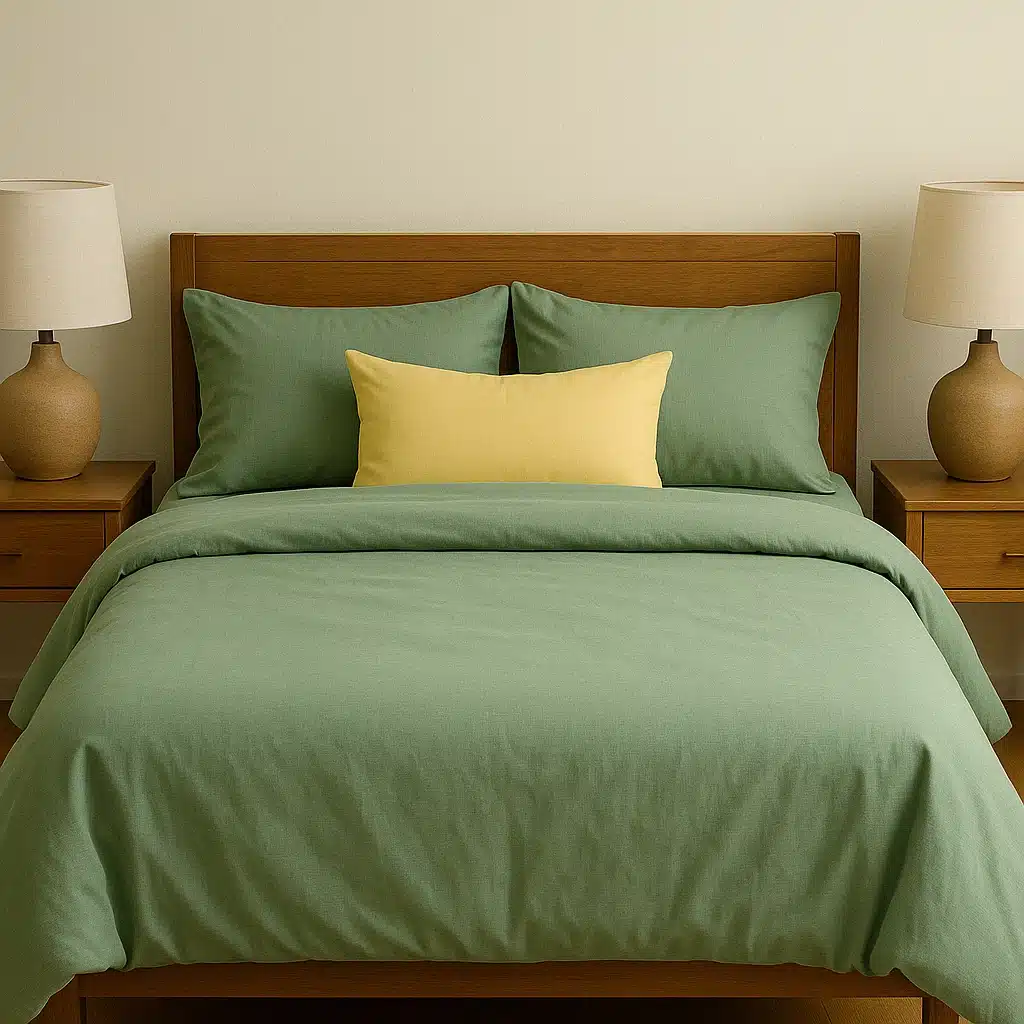Sustainable bamboo bedding is popping up everywhere these days. Some say it’s the future of eco-friendly sleep. Others aren’t so sure. And with every brand claiming their sheets are “sustainable,” it’s hard to know what’s real and what’s just a sales pitch.
Let’s be honest, though—most of us don’t shop for bedding just to help the planet. We shop because we want better sleep. Maybe you’re tired of waking up hot and sweaty. Maybe your current sheets feel rough or irritate your skin. Or maybe you just want something that feels a little more…luxurious.
That’s where bamboo comes in. Here’s what makes it worth checking out—and a few things you’ll want to keep in mind before you hit “add to cart.”
Covered Below
Bamboo’s Bigger Impact on the Planet
Bamboo bedding might be where you first hear about it, but bamboo itself does far more for the environment than most people realize.
Bamboo’s Natural Carbon-Capturing Power
Did you know bamboo absorbs more carbon than most trees? Some species can soak up 12 tons of CO2 per hectare each year. And it releases 35% more oxygen than a forest of the same size. You’re not just getting softer sheets—you’re supporting one of nature’s best climate helpers.
Water Efficiency That Beats Cotton
Sustainable bamboo bedding starts with how the plant grows. Bamboo needs about one-third the water of cotton, and it grows just fine without pesticides or fertilizers. It even thrives in poor soil. So if water conservation matters to you, bamboo might feel like the smarter pick.
What Bamboo Bedding Feels Like (And Why It’s So Popular)
Let’s get real—feel is everything!
Bamboo sheets feel buttery soft right out of the package. No roughness. No break-in period. Just smooth, silky comfort from night one. And they only get softer with every wash.
But the feel isn’t the only thing people love. Bamboo fibers let air move through easily and pull moisture away from your skin, keeping you cool and dry. If you wake up sweaty or overheat easily, bamboo could be a game-changer.
And if you’ve got sensitive skin? You’re in luck. Bamboo is naturally hypoallergenic and less likely to trap dust mites or irritate your skin like some synthetic fabrics can.
Plus, with good care, bamboo bedding can last 5 to 15 years—much longer than cheaper cotton that wears thin after a few seasons.

What to Watch Out For: Greenwashing and Monoculture Risks
Not all bamboo bedding is as green as it sounds. Here’s what brands don’t always tell you:
- Chemical Processing: Some bamboo fabrics are made using harsh chemicals that aren’t exactly planet-friendly. Look for bamboo lyocell or OEKO-TEX® certified products to avoid this.
- Monoculture Farming: Huge bamboo plantations can push out other plants and wildlife. Look for brands that talk about responsible sourcing or FSC® certification.
It’s easy to get tricked by the “eco-friendly” label. Check the details before you buy—or take a moment to learn how bamboo fabric is made so you know exactly what to watch for.
Bamboo Bedding vs. Cotton and Linen
| Feature | Bamboo Bedding | Cotton Bedding | Linen Bedding |
|---|---|---|---|
| Sustainability | Highly renewable, low water use | High water and pesticide use | Very sustainable, low water use |
| Softness | Buttery soft from day one | Scratchy at first, softens over time | Crisp feel, softens with use |
| Breathability | Excellent airflow, moisture-wicking | Good, but holds moisture | Superior breathability |
| Moisture-Wicking | Absorbs and evaporates moisture fast | Holds onto moisture | Dries quickly |
| Durability | Long-lasting with proper care | Wears faster, needs replacement | Extremely durable, long lifespan |
| Care | Gentle wash, air dry or low heat | Tolerates machine wash/dry | Benefits from gentle care |
| Price | Higher upfront, better long-term value | Lower upfront, more frequent buying | High upfront, lasts decades |
Why It’s Worth the Extra Cost
Sure, bamboo costs more up front. But here’s why it makes sense:
- You buy less often, which saves money (and reduces waste).
- It lasts longer—up to 15 years if you take care of it.
How Your Bedding Choice Supports the Bigger Picture
Your choice matters more than you think. Bamboo farming helps prevent erosion, restores land, and supports small farmers in places like Africa, Asia, and Latin America. It’s more than just bedding—it’s part of a bigger solution.
Why Certification Matters for Your Health
Cheap bamboo bedding might feel soft, but it could hide chemical residues like formaldehyde or carbon disulfide. That’s not great for your skin—or your health.
Look for OEKO-TEX® Standard 100 or FSC® certifications. These labels mean your bedding has been tested for harmful chemicals and made in more eco-friendly ways.
How to Help Your Bamboo Bedding Last Longer
Want your bamboo sheets to stay soft and last for years? Here’s what to do:
- Use cold or lukewarm water—hot water breaks down the fibers.
- Skip fabric softeners—they coat the fibers and ruin the softness. And you don’t need them anyway.
- Pick a gentle detergent—nothing harsh or heavily scented.
- Air dry or tumble dry on low—high heat can shrink or weaken the fabric.
- Don’t overload your washer—give your sheets space to move.
A little extra care goes a long way.
Extra Tips and Insights You Might Not Have Heard
Clearing Up the Microplastics Myth
One common worry is whether bamboo sheets shed microplastics, like polyester or microfiber bedding. The good news? 100% bamboo sheets don’t. Bamboo is a natural fiber—there are no synthetic materials to shed tiny plastic particles. But watch out for blends that mix bamboo with polyester or microfiber. Always check the label to be sure you’re getting the real thing.
Bamboo Lyocell vs. Viscose: What’s the Difference?
Not all bamboo bedding is made the same way. If you spot the words “viscose” or “rayon”, it means the bamboo was processed using heavy chemicals. This method can still produce soft sheets, but it’s not the most eco-friendly option.
Bamboo lyocell is the cleaner choice. It’s made using a closed-loop process that recycles water and solvents, reducing waste and pollution. If sustainability matters to you, lyocell is the better pick.
Real-Life Buying Mistakes to Avoid
It’s easy to get distracted by color options, thread counts, or flashy photos. But one thing many people overlook is the weight of the fabric. Super-thin bamboo sheets might feel soft at first, but they tend to wear out faster, especially at the seams.
If you can, check the GSM (grams per square meter) or look for words like “heavyweight” or “luxury weight.” This gives you a better idea of the sheet’s thickness and durability. If that information isn’t listed, the sheets might be on the thinner, lower-quality side.
What’s Next for Sustainable Bamboo Bedding?
With more people choosing eco-friendly products, brands are stepping up their game. Cleaner production methods, better materials, and real transparency are slowly becoming more common.
And here’s the thing—what happens next depends on all of us. The more shoppers ask questions and choose brands that actually back up their claims, the greener bamboo bedding can get in the years ahead.
Frequently Asked Questions
- How can I avoid greenwashing? Skip vague labels like “eco-luxury” and look for real info about sourcing, processing, and certifications.
- Is bamboo bedding environmentally friendly? Yes, when it’s made responsibly. Look for bamboo lyocell and OEKO-TEX® certifications.
- What’s the downside to bamboo sheets? They need a bit more care—no hot water or fabric softener, and low heat for drying.
- Is bamboo better for the environment than cotton? Usually, yes. Bamboo grows faster, uses less water, and doesn’t need pesticides.
- How long do bamboo sheets last? Anywhere from 5 to 15 years, depending on how you care for them.
- Are bamboo sheets worth the hype? If you like soft, cooling sheets that last, they’re worth it.
- Is bamboo bedding safe? Stick with OEKO-TEX® certified options to avoid harmful chemicals.
- How can I tell if bamboo bedding is really eco-friendly?
- Check for labels like bamboo lyocell, OEKO-TEX®, or FSC®.
- Which is better—bamboo, linen, or cotton? Bamboo for softness and cooling, linen for breathability, cotton if you’re on a tight budget.
Final Thoughts: Is Sustainable Bamboo Bedding the Right Choice?
Sustainable bamboo bedding can be a great fit if you care about comfort, skin health, and the planet. But not all products are created equally. Look beyond the label, check the process, and choose brands that are honest about what they’re doing. Choosing the right sustainable bamboo bedding makes a real difference—both for your comfort and the environment.
Making small swaps like this adds up, especially when you’re building a greener home.
Ready to make the switch? Take a look at my top picks for eco-friendly bamboo sheets to find one that fits your lifestyle and your values.

Kristin is the founder of Eco Bamboo Living. She shares honest, research-backed guides and product reviews to help readers find bamboo products that are truly sustainable, practical, and worth bringing into their homes.

